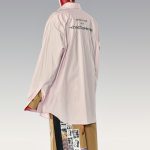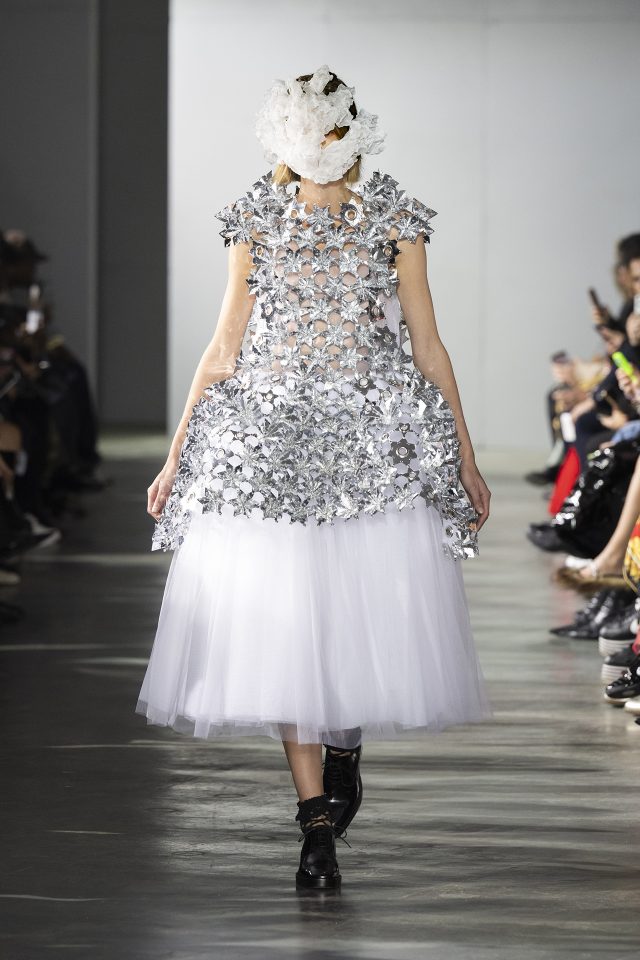編集者・斎藤和弘インタビュー
Kazuhiro Saito
Photography: Hidemasa Miyake
Interview & text: Miwa goroku
元コンデナスト・パブリケーションズ・ジャパンの代表取締役でありながら『VOGUE NIPPON』(現『VOGUE JAPAN』)と『GQ JAPAN』の編集長も兼務していた、伝説的な編集者・斎藤和弘のロングインタビュー
編集者・斎藤和弘インタビュー
Magazine
*You’ll find the English text after the Japanese.
コンデナスト・パブリケーションズ・ジャパンの代表取締役を務めながら、『VOGUE NIPPON』(現『VOGUE JAPAN』)と『GQ JAPAN』の編集長も兼務していた斎藤和弘氏が、突然同社を退社する旨を公表して業界を騒がせたのは、いまからおよそ3年前のことだ。退社後は「毎日が夏休み」と話す斎藤氏だが、抜群のビジネス感覚を備えた稀有な編集者の才能を周囲が放っておくわけもなく、現在も新旧複数のメディアからの招聘に応じながら、編集者やアドバイザーとしての活動を続けている。
バブル崩壊後に低迷していた『BRUTUS』を一気に黒字媒体へと転換させ、さらに兄弟誌『Casa BRUTUS』の創刊で時代の波をいち早く先取りし、『VOGUE NIPPON』では広告主導のラグジュアリーなメディアとしての地位を確立させるなど、雑誌業界において常に頭ひとつ抜けた存在であり続けた斎藤和弘氏に、ここでは改めて「雑誌とは何か?」という話から聞いていこうと思う。続けて、「ラグジュアリーブランドは今後どこへ向かうのか?」「ファッション写真は本当に終焉したのか?」というふたつのトピックスをもとに敢行したインタビューを、全4回にわけてお送りする。
雑誌と新書とウェブ。いまストーリーはどこに流れているか?
—雑誌編集者としての斎藤さんに、改めて「雑誌とは何か?」という話からお伺いしたいと思います。以前どこかで、雑誌の特性は「ストーリー」にある、という趣旨の話をなさっていたことが記憶に残っていますが、斎藤さんがおっしゃるところのストーリーは、たとえば現場で編集部員が日々考えている具体的なコンテンツとしてのストーリーとは違うものですよね?
違いなんてないですよ。ただ、それがファクトの羅列になるのならば、情報としてデジタルには敵わないので、そんなことはやめたほうがいい。いっている意味はそういうことです。別にデジタルを意識してストーリーの話をしたわけではないのですが、気がつけばいまウェブの世界にはデジタルの膨大なファクトの集積ができている。そこに雑誌との違いがあるとしたら、最大の違いはストーリーがあるかないかということでしょう。その場合のストーリーとは、起承転結であり、物語性みたいなことです。雑誌は基本、編集者がそれぞれにストーリーを考えて作っていけばいい。
—いまの雑誌はストーリーを紡いでいるでしょうか?
最近、というかもともと雑誌は見ないのですが、いまってね、何かこれはとぶち当たることがない。クリエイションは不在の時代だし、あるいは不在にするしかないのかもしれないし。わからないです。不思議ないい方をしますが、紙の媒体でいくと、いまは雑誌より新書のほうが圧倒的に雑誌っぽい。なぜかというと、そこにストーリーと驚きがあるからです。新書は200ページくらいある中で、どういう物語を紡ぐかというのが確実にある。そこでヴィジュアル的なものは成立しませんが、考え方としては雑誌と似ているなと思います。1冊1冊がまさに雑誌の特集ですよね、そしてそのジャンルがやけに広い。文字だけで成立しているから、あらゆるところが可能になっている。いまは1ヵ月に10冊近くの新書を出す出版社がたくさんあるので、毎月200〜300冊くらいは出ているのではないでしょうか。

Photo by Hidemasa Miyake | © The Fashion Post
—新書で「驚き」を感じるポイントはどこですか?
エンターテイメントであるということです。根本的に、雑誌ってエンターテイメントですから。人の持っている価値観を揺るがすという意味では、いまは雑誌よりも新書のほうが圧倒的にそうであるという話。おそらく優秀な編集者がそこにいるのでしょうね。人を探そう、書き手を捜そうとか、そういうことに関しても、優秀な人が多いのだと思います。
—さきほどの話で挙がったデジタルに関して、いまは個人ブログやSNS、ニュースサイトなどがどんどん拡大していますが、雑誌からウェブへとシフトする動きはどうご覧になっていますか?
ウェブは間違いなく大きくはなります。ただし、雑誌とはまったくの別ジャンルです。テレビと雑誌は比べないでしょう?でもみなさんなぜか、雑誌とウェブは比べたがるんですよね。おそらくスチール写真とテキストという極めて似た構造になっているからだと思いますが、そこはやっぱり別物なので。別物を比べるのは意味がないと思います。
—では、ウェブ単体の評価軸で見る場合はどうでしょう。情報伝達の早さだったり、個人発信ができることなどについては?
まったく興味がないです。良かったなと思うのは、アナログなまま終われる私の人生。仕事的にはデジタルをやらなくてもすむ世代でいることは、本当に良かったと思っています。雑誌がなくなるということは絶対にないですから。いまこうしてプー太郎をしている間にも、雑誌を作ってくださいっていう話がきますしね。そうするとけっこう楽しみながら作れますよ。
—編集者として現在関わっていらっしゃるプロジェクトなどはありますか?
最近、JP(日本郵便)のプロモーション用の雑誌を作りました。JPタワー(の商業施設「KITTE」)がオープンする前の3月15日に発売になりました。一応雑誌と銘打っていますけど、見た目は雑誌というよりはプロダクトかもしれない。300ページ前後で980円。全ページが絵葉書になっているんです。絵葉書をくっつけたのではないですよ、ちゃんとストーリーが流れるんです。で、切り取ると絵葉書になっていくというやり方。たぶん世界初です。ショップのガイドにもなっていますが、やっぱりただのガイドではない。たとえばJTBのページには、みうらじゅんさんと安齋肇さんの2人が日本中を観光して歩くという絵葉書がいっぱいあります。かなり笑えます。
—アイデアがすごいですね。斎藤さんは今後、ご自身で新しいメディアを作りたいとか、そんな思いはありますか?
全然ないです。
—もし自由に作れる場所があったら?
昔から夢はひとつあるのですけど、それはお金がかかるし。もし失敗したら大負債を抱えるからたぶんやりません。
—ではお金がたくさんあったら?
写真週刊誌です。週刊誌ということは、年間50冊。つまり50人のフォトグラファーです。ただしフォトグラファーが先に立つのではないですよ、テーマが先にあるんです。たとえば「昆虫」でいいんです。栗林慧さんという、すごく面白い昆虫カメラマンがいるのですが、この人の100ページでいい。それを世界5〜10都市で同時発売します。
—スケールが一気に広がりましたね。となると実質的には週1ペースでフォトグラファーをブッキングしていくわけですか?
いや、ストックはみなさん持っているんですよ。アマチュアまで含めれば、世界中にいったい何万、何十万人のフォトグラファーがいると思いますか?彼らはみな、それぞれテーマを持って撮影しています。鉄ちゃんだけを見てみても、たとえば京浜急行だけを撮っているとか、いまとなっては相当細分化されていますからね。ここで問題となるのは、それが面白いかどうかです。つまりやり方としては、世界中から毎年50種類の面白いものを集めてくれば良いということです。あとはアートディレクターだけちゃんとしていれば、週刊誌として成立してくるでしょう。そうすると何が良いかって、たぶん毎週20万部くらいは出るだろうから、ひとつのテーマのフォトグラファーにギャラを1000万円くらい渡すことができる。ある日突然、それまで撮り貯めていた写真で1000万のギャラが入るんです。その人はそれで暮らしていけるようになるかもしれないし、っていう。これが夢です。
—斎藤さんの口から聞くと、実現しそうな気がしてしまいます。
ムービーではなく写真でやるというところが重要です。毎週何が出てくるかわからないって、面白いでしょう。『YouTube』にアップしました、では意味がないんです。いくらネット社会だとはいえ、私たちには見たことのない写真というのが世界にはいっぱいあるんですよ。
—ちょっと視野を広げるだけで、世の中面白い人だらけですからね。
本当にそうなんです。世の中面白い人だらけなんです。また鉄ちゃんの話になりますが、かつて蒸気機関車が走っていた時代にプロでやっていた第一人者の写真を見ていたらね、たとえば「函館本線D51機関車、2連結で雪の中を逆走する」とか、とんでもない写真がいっぱいあるんですよ。そういう写真は年末になるとカレンダー用に異常な数がストック写真として出ていくから、彼はすごい別荘を持っていました。写真は可能性がありますよ。
—写真は昔から変わっていないということですか?
変わってない。そこが写真の面白いところです。1850年代に写真というものが成立して、そこから撮られている写真といまの写真の違いといえば、いまは電気工学ですが、昔は化学工学だったということくらいです。写り方というのは、基本的に変わっていない。たとえばポートレートを撮る場合でも、人がカメラの前に立つとどうしてみんなこうなっちゃうの?と思うくらい、人の顔も動き方も昔から一緒です。
19世紀の半ばに、近代写真のもとを作ったナダールという人がフランスにいまして。その写真館がパリにありました。いまでいうなら東條会館とか銀座の有賀写真館みたいな感じかな。当時において、そこはフランス最高の社交場です。写真を撮ってもらうというのは、ある種のステータスだったのですね。だからその写真館には、あらゆる人たちが集まっていました。そこには徳川慶喜の弟である昭武とその随行員一同の写真も残されています。全員が時代劇のような衣装、というかそれこそ本物なわけですが、その格好でひとりずつポーズをきめて写真を撮られている。いまでいうならば、市川海老蔵が衣装を着てポーズをきめているのと、まさに同じような格好です。それが本当にその時代にあったのだとわかります。面白いでしょう。
ラグジュアリーの条件。ブランドはどこに成立するのか?
—次はビジネスの話です。いま、ファッションメディアがスポンサーをとっていくために必要なことは何でしょうか?
それは営業力でしょう。コンテンツ力も必要ですけど、それがあってもどうにもならないことがたくさん出てくるので、やはり営業力です。ある程度の営業力さえあれば、コンテンツが面白くなったらスポンサーは来ます。あるいは、コンテンツをどう説明するかということが必要なわけで、そこが出来なかったらダメです。雑誌は一番わかりやすいですよ。ファッション誌に限らず、雑誌には読者とクライアントというふたつのお客さんがいますよね。B to Cというのは、売れた売れないが見える世界なのでわかりやすい。販売率がいくらで部数がこれくらいで、という話です。問題はB to B。ビジネスとして圧倒的に大きいのはB to Bですから。クライアントにどうやって売るのか。あるいはどういう料金設定にするのかという話です。料金設定というのは実はすごく大事で、ここをきちんとしておかないと、先々メディアとして成立しなくなります。日本の場合、ファッションでいくと雑誌がほとんどなので、単価をしっかり設けていないところはダメということです。そうなると、日本は全部ダメということになります。ディスカウントするし、明快じゃないし、いろんなことがクリアではない。そこをクリアにした上で、コンペティターの中で一番高い値段を取るというのが、ブランディングの基本です。一番高いというのは、量ではなく単価です。ファッションに限らず、あらゆるもののブランディングの基本が単価です。たとえばこの「バカラ」のグラスは2万円。高いです。同じような形態のグラスはたぶん1000円以下でもたくさんあります。何かを飲むという機能はそれぞれ違いますか?どれも一緒でしょう。ではどうして「バカラ」を選ぶのか?わかりますよね、ブランドだからです。メディアも同じです。広告の単価が一番高いところにブランドが成立するんです。雑誌でいくと、1P広告の単価が一番高いところがブランドなんです。それを値引きしちゃったらおしまいです。
—ちょっと耳が痛い話ですが、斎藤さんがそれを『Vogue』で実践していらっしゃったのは有名な話ですね。
絶対値下げしてはいけない理由、わかりますか? 下げ始めたら価格競争になるからです。価格競争になると何が起きますか?コモディティ化が起こるんです。つまり安売りになってしまう。これは液晶テレビと一緒です。アクオス (シャープ) はブランドでした。でもいつの間にかベガ (ソニー) と変わらない値段になった。どうしてそうなったのか?もうひとつ似たような比較で、ヴィッツ (トヨタ) とフィット (ホンダ) がありますが、こちらもコモディティ化してよさそうなのに、叩き合いになっていない。なぜか?車は流通を抑えているからです。自分のところのディーラーが売るから。一方の液晶テレビは家電量販店が売っている。つまり流通が抑えられていない。これは Bernard Arnault (ベルナール・アルノー) が必ずいう言葉ですが、ブランディングを、ラグジュアリーをおさえる基本は流通なんです。価格は流通で統制をしないといけない。もうひとつはイメージの統制です。価格とイメージのコントロールというのが、ラグジュアリーにとっては一番大事な部分です。外部工場と卸に出してはダメ。つまり自分のところでモノを作らないといけない。そうすることによって、イメージのコントロールができて、価格のコントロールができる。
—とても分かりやすい説明をありがとうございます。
いま、明治大学の商学部で、ファッションビジネス論というのを教えていますからね。ちょうど1年やったところです。
—特任教授に就任なさったんですよね。来年度も継続ですか?
5年の予定です。一昨年の暮れに、商学部の学部長から電話がありまして。商学部には北川景子もいると聞いて即諾したんですけど、いざ去年の4月に行ってみたら、彼女はもう卒業……残念でした (笑)。でも明治はいま、日本で一番受験者数の多い大学だと知って、大学のビジネスっていうのはこうやればいいんだというのがよくわかりましたよ。大学は4月にデポジットがボンと入りますよね。3万人の学生から300億円。11万人の受験生から50億円。だからコストコントロールだけなんです。問題はどうやったら人がたくさん来るか。つまり大学もある種のブランディングなんですよ。
—ファッションの話に戻りますが、ラグジュアリーブランドビジネスの今後について、どうご覧になっていますか? 若い層を中心に、ブランド離れがいわれて久しいですが。
日本にいると、ラグジュアリーってもう終わったんじゃない?という風に見えるのかもしれませんが、世界的に見たらこんな成長産業は他にないです。LVMHグループの2012年度の決算を見てください。総売上高は前年比19%増です。もちろん新しいマーケットが広がっているというのがありますが、そもそもヨーロッパとアメリカでも売り上げは確実に伸びているんです。日本だけが伸びていない。なぜ伸びていないかというと、日本は既に伸びすぎているというのと、お財布をそんなに買わなくなったから。それだけの話です。
じゃあ日本から撤退するかというと、するわけはない。ラグジュアリーの世界で、日本のマーケットシェアは、平均するとまだ20%以上あります。日本20%、アメリカ20%、中国22〜3%くらい。この3つがラグジュアリーのメイン消費者です。さらに日本人が海外で買っている分まで合わせたら、数字はもっと上がりますから。終わりでも何でもないです。ただ、日本国内の店舗数に関しては減ると思います。だいたいどのブランドも50〜60店舗、下手すると80店舗くらいあったんですけど、そこから2割くらいは減るんじゃないかな。要するに、ラグジュアリーのショップは百貨店の中にしかないので、特に地方の百貨店はいまダメになっているから、そこがなくなっていく。そういう構造です。
—アジア圏内で見ると、日本よりも中国に投資が向いているニュースが多い印象ですが。
いまは中国にお金をかけていますが、ラグジュアリーにとっての日本は、1980〜90年代にかけて世界で最も良いマーケットだったんですね。そして投資効率からいうと、いまだに日本ほど効率の良い国はないです。たとえばショップ店員の教育。日本には特に教育しなくてもすぐに使える人材が揃っていますが、同じことを中国でやろうと思ったら、まずは学校を作らなければいけないくらい、本当に育っていない。あともうひとつ。これほど急激に高齢化社会になっていった時、ラグジュアリーはどうやって生き延びるのか?というのを探るラボとしても日本は使えるんです。ラグジュアリーにとって、これは本当に大事です。なぜなら中国も20年くらい先には高齢化に向かいますからね。人口動態からいうと、ヨーロッパは変わらない。アメリカはいつまで経っても上昇し続けています。私が大学生の頃は人口2億人でしたが、いまは3億人を突破していますからね。でもアジアは違う。移民をたくさん迎えない限り、下降していきます。
—ラグジュアリーの在り方も変わることはないでしょうか?
変わらないですよ。ただ、何をもってラグジュアリーというのかは、また別の問題です。ここをちゃんとしておかないと、話は先に進みません。いつも必ず言っていることですが、ラグジュアリーを理解するためには、まずプレミアムという補助線を引いてみてください。そうすると、ラグジュアリーとは何かがよく分かります。たとえばフェラーリとレクサス。この違いは何ですか?レクサスはどこまでいってもラグジュアリーにはならないですよね?それは時間とか歴史の問題じゃない。簡単に言うと、コストパフォーマンスの問題なんです。ある機能を、最低のコストで最大限に発揮するというのがコスパ。これを追求した最高級のものがプレミアムなんです。450万円のレクサスほど車として完成されたものはない。3000万円のフェラーリほど無駄な車はない。でもフェラーリは、ラグジュアリーです。
ゲイと女子。ファッション写真は本当に終焉したのか?
—以前、『WWDジャパン』のファッション・ウェブ・アワード2011で、ファッション写真の終焉についてコメントなさっていましたが、具体的なエッジはどこにあるのか、もう少し伺いたいと思っていました。
1980年代から90年代にかけての、ほぼこの四半世紀の間に、ファッション写真は滅茶苦茶に大掛かりなものになりました。Gucci (グッチ)、LOUIS VUITTON (ルイ ヴィトン)、CHANEL (シャネル) など、メガブランドのシーズンキャンペーンに、膨大なお金がどんどん投入されたわけです。このキャンペーンの考え方自体が最初に出てきたのはもう少し前で、Calvin Klein (カルバン クライン)、Giorgio Armani (ジョルジオ アルマーニ)、Ralph Lauren (ラルフ ローレン) あたりがブランドとして成立し始めた70年代後半までさかのぼります。ここが、ブランディングのために使うADキャンペーンの始まりです。ハイエンドモードのグローバル化が進んで、そのビジネスモデルというのがアリだなとみんな気づき始めたわけです。Peter Lindbergh (ピーター・リンドバーグ)、Steven Meisel (スティーブン・マイゼル)、Bruce Weber (ブルース・ウェバー) 等々。たとえば2000年前後に Calvin Klein のシーズンキャンペーンを手掛けた Steven Klein (スティーブン・クライン) は、2週間でギャラ3億円とか言われていましたから、彼らはある種のミリオネアですよ。ただしその契約は、カタログから何から全てを撮るというものなので、クラインはひと月弱スタジオに籠りっぱなしだったって言っていましたけど。とにかくそういう時代でした。
そして1994年、Tom Ford (トム・フォード) が Gucci のクリエイティブ・ディレクターに就任した時、彼がやったことは何だったか。メガストアとメガキャンペーンです。世界中の主なメガロポリスにはメガストアがあり、そこでは世界同時にメガキャンペーンが貼られていて、というやり方です。ハイエンドファッションは非常に投資対象になりますよ、という世界です。それでどんどんお金が入ってきました。どんどん使って、ファッション写真はそういうものになってきました。気がついたら、そこだけが肥大化していました。いまや世界中のあらゆるブランドがメガキャンペーンをやっています。モード誌に必ず載せます。で、いまどうなっていますか?みんな飽きていませんか? そもそも1キャンペーンで出てくる写真は、せいぜい10枚かそれより少ないくらいです。そんな効率の悪いことは、みんなもうやらないでしょう?ファッション写真の終焉とはそういうことです。
—そしていまは、スナップ的なアプローチの写真が台頭している。
そう。いまはADキャンペーンっぽいものではなくて、むしろブロガーが撮っているようなスナップ写真のほうがファッションなんじゃないの?という時代になっている気がしますね。作り込んだものよりも、リアルなもの。何をもってリアルというのかは難しいですけれど。たとえばハイエンドモードの頂点がパリコレだとします。その場合、パリコレのクリエイションを作った人は誰ですかといったら、デザイナーですよね。ほぼ全員男ですよね、でも誰もメンズの話はしません。ファッションでメンズは付け足しでしかない。基本的にはウィメンズの話です。では、そのウィメンズのクリエイションを作っているのは誰ですかといったら基本的に男で、彼らはほぼ全員ゲイです。じゃあそのゲイの人たちは,何を思ってこの女性のファッションを作っているのですかといったら? ある種の理想の女性像を作り上げているわけでしょう。それは洋服であろうがメーキャップであろうが同じです。問題は、そのビューティを追求している人が実は男、ゲイであるということです。つまりそこには非常に人工的で、想像上の世界が広がっています。だからパリコレは面白いんです。だけど考えてみましょうよ、そうやって人工的に作ってきた世界って、みんな居心地が悪くなっていませんか?と。その辛さが、20世紀の終わりとともにだいたいみんな見えたわけです。
—なぜ急にリアルファッションになったのでしょう?
最初はおそらく Chloé (クロエ)。Stella McCartney (ステラ・マッカートニー [1997年〜]) と Phoebe Philo (フィービー・ファイロ [2001年〜]) が手掛けていた頃の Chloé です。パリコレのなかでは唯一、ゲイでなければオバさんでもない、30歳前後の自分たちが着たい服を作ったコレクションでした。女性の若いデザイナーはもちろん他にもいましたが、この2人は最も注目されるブランドでリアルを作ったということです。以来、みんなどんどんリアルになってきました。なぜ急にリアルになったのかというと、みんななんとなくそう思っていたからです。そうなってくると、莫大なお金をかけてファッション写真を撮る意味もなくなってきますよね。
たとえば Marc Jacobs (マーク・ジェイコブス) は以前からずっと Juergen Teller (ユルゲン・テラー) を起用してADキャンペーンをカシャカシャと撮り続けていますが、やっぱり Marc は早いですよ。あるいは Terry Richardson (テリー・リチャードソン) を起用して撮るというのも、いまのスタイルなのだと思います。で、その究極が Bill Cunningham (ビル・カニンガム) でしょう。去年アメリカで彼のドキュメンタリー映画が公開されて話題を呼んでいる、『The New York Times』のスナップフォトグラファーです。彼は元祖ブロガーです。実際にブログはやっていなくても、彼が50年にわたってやり続けていることはブログの原型なんです。
「はっきり」と「ぼんやり」。いま面白い写真とは?
—夢から醒めたという感じですね。リアリティを感じることが大事な時代になったと。
デザイナーにしてもフォトグラファーにしても、ファッションのクリエイションにおいて立派な人はゲイであり、彼らはずっと「こうあるべき」だと主張してきた。だけどね、こうあるべきだという「はっきり」したものは、自分じゃないから成立するんです。もしこれが女性だった場合は、それほどはっきりとは言えないものです。だからいまのファッション写真、つまりスナップ的なものに写っているのは「はっきり」じゃなくて「ぼんやり」。こうあるかもしれないし、こうじゃないかもしれないけど、いまの気分はこんな感じ?というような「ぼんやり」感です。でもそれがいまはリアルであり、ファッション写真になっているのでなはいかという気がします。
—いま注目しているフォトグラファーはいますか?
具体的に誰?と言われたら困りますが、でも最近、カメラ女子っているじゃないですか。カメラ女子の写真は、ぜんぶ「ぼんやり」ですね。だけどそれは女性だからじゃない。2013年春号の『WWDマガジン』でも書きましたが、女性カメラマンというのは昔からずっといます。たとえば最近の話題で、あの有名な報道カメラマンの Robert Capa (ロバート・キャパ) が、実は Gerda Taro (ゲルダ・タロー) というドイツ人女性と共同で名乗っていた架空の名前だったというのがあります。その驚きというのは、そこに女性フォトグラファーがいたということではない。彼女が撮った写真が、男が撮った写真と差がなかったということです。つまり彼女は、写真はこうあるべきだと思って撮っている。その頃『LIFE (ライフ)』が創刊(1936年) されるのですが、創刊号のカバー写真を撮った Margaret Bourke-White (マーガレット・バーク=ホワイト) さんという人もやはり女性で、その写真は「はっきり」しています。ところがいまのカメラ女子というのは、こうあるべきだと思って撮っていない。被写体に対して、すごく「ぼんやり」している。ぼんやりする理由は、「私の感覚」だからです。感情や情感みたいなもので写真が成立するようになってきている。だけどそれがリアル。それと同じように、ブロガーの写真もスナップ写真もそっちの世界なのだと思います。
—写真が本来持つ強さみたいな部分も、ぼんやりしていくのでしょうか。
そうなるとね、困ったことが起きるんですよ。私より上の世代というのは、何においても美しさ以上に強さというのがクリエイションを評価するポイントだという風に考えてきたわけです。で、日本が一番ダメなのはここだと思っている。つまり日本人の表現はすごく美しかったり細密だったりするものの、パワーがない。パリコレを見てみても、いま日本人デザイナーがたくさんいますよね。でもあまり評価されない理由はパワーがないから、とそういう風にみてきたわけです。唯一パワーがあるのは COMME des GARÇONS (コム デ ギャルソン) 。COMME des GARÇONS には、表現としての強さがある。
写真でも、やっぱり強さが一番求められてきました。たとえば日本のフォトグラファーの中には、本当にスキルが高い人がいっぱいいます。でも強さがないから、いまいち評価されてこなかった。ただね、いまは強さなき時代になっている。だからもしかしたらこれから先、日本人も評価され始めるかも……という気がしないでもない。
—雑誌を見ていても、「はっきり」した写真は明らかに減っています。
それこそ Mert & Marcus (マート&マーカス) とか Steven Klein (スティーブン・クライン) みたいな写真って、いまやほとんど見かけないでしょう。それが古臭いなんて誰もいいませんが、いってみれば古臭いですよ。
—少し脱線しますが、Mert & Marcus に関しては、海外の雑誌では近年急に巨匠たちと名を連ねるようになった気もしますが。
巨匠といっても Mario Testino (マリオ・テスティーノ) や Mario Sorrenti (マリオ・ソレンティ) あたりはまだ若いですよ。Mert & Marcus にしてもいまやっと40を過ぎたくらいでしょう。彼らは Katie Grand (ケイティ・グランド) と仲がいいから、最近『LOVE MAGAZINE (ラブ・マガジン)』でよく一緒にやるようになってそう見えるのではないかな。広告キャンペーンは、彼らもけっこう前からやっています。あとは、Mert & Marcus だけはロンドンベースということもあるかもしれない。いまの有名どころのフォトグラファーは基本、『VOGUE ITALIA』で Franca Sozzani (フランカ・ソツァーニ) が発掘して育てた人がほとんどですから。
—ファッション写真とは、改めて何でしょうか。これからどのように変わっていくと思いますか。
表現の場所が普及してしまったじゃないですか。みんなネットに上げればいいだけ。そういう世界になってきたら、当然変わりますよね。独断と偏見で申し上げると、20世紀の半ばすぎに、ファッション写真のほとんどの型は出来あがっているわけです。それ以降は、その引用と解釈の問題だけ。写真というものが19世紀半ばに出来上がってから、20世紀の初めくらいにはもう構図から何からあらゆることが、ほぼ全て試され尽くしています。
—Richard Avedon (リチャード・アヴェドン) や Irving Penn (アーヴィング・ペン) 以前に、写真は完成していたということですか?
彼らがちょうど、草創期の写真と引用の写真の境目です。つまり1950年代から60年代前半あたりが境界線です。それ以降の人たちは、簡単にいうと引用。これはしょうがないですよ。写真、特にファッション写真は、そういうものですから。ファッションのストーリーの打ち合わせは、フォトグラファーとファッションエディターの基本2人でやりますよね。そこでどういう会話をするかといったら、基本は映画と過去のファッション写真の話なわけです。それが共通理解であり、絵コンテなどは存在しません。たとえばブラックのストーリーを作ろうとなった時、あの時の Audrey Hepburn (オードリー・ヘプバーン) が着ていたこんな感じ?という話になれば、あぁそれだったら Richard Avedon の『VOGUE』じゃなくて『Harper’s BAZAAR』の頃のこういう写真だよね? という風に会話が成立していく。それでストーリーができる。だから、どうやったって引用の世界になってくる。まったく新しいクリエイションというのは、基本的にそこには成立しないです。
—ここで名前が挙がってきたフォトグラファーたちは、私たちから見ると揺るぎないポジションにいるように感じますが、近い将来、顔ぶれが変わるという可能性もあるのでしょうか?
フォトグラフフィーにとっての90年代が、一瞬のバブルであったのは確かです。ただね、Steven Meisel (スティーブン・マイゼル) たちの頭の中に入っているイメージストックの膨大さといったら、それはもう半端な量じゃないですよ。日本のフォトグラファーは、誰もそこまでいっていません。まず、喋れない。語学力の問題ではないです。Mario Testino と喋っていると、彼はペルー系イタリア人だから、実際のところ彼の英語は何を言っているのか本当にわかりませんが、それは具体的な英語の話であって、イメージの話は別ですから。
—ただし、ファッション写真はもはや憧れとして見るものではないという見解ですね。
ない。と私は思います。ネット見ればよくわかりますよね。東京でギャル向けのサイトなどを見ていると、写真に憧れるのではなくて、それを着ているモデルだったりプレスに憧れているのがわかる。かつてセレブが着るとモノが売れるといわれた時代がありました。それはいまでもそうなのですが、そのもうちょっと安いバージョンが、いまやギャルマーケットで行なわれている。だからいつまで経っても日本では写真は成立しないなと思いますね。
それにいま、写真の世界でいくと、男の人がとったファッション写真よりも、カメラ女子じゃないですけど、女の人たちがとった自分たちの姿の写真のほうが、圧倒的に面白い。そのほうがファッションを感じます。
—そうなると、クリエイティブに関して難しい時代ですね。
難しいですよ、自分のことしか考えちゃいけないですから。自分でネットに上げてったほうがいいんじゃないですかという話。でも、じゃあそれは同人誌とどう違うのですかという話にもなります。同人誌的なものやプライベートな発言や表現をする機会が増えているのはすごくよくわかるのですが、でもあれほど見ていて辛いものはない。私は雑誌としては、商業誌以外は信用しませんから。同人誌は、どこまでいってもやっぱりエンターテイメントになってない。
—クリエイティブを追求するインディペンデントな雑誌も、ここ最近また増えている印象です。
私は30年以上編集をやってきたから自分でも思うのですが、雑誌の編集って、基本的には何もしたくない人がやることですよ。基本的にはコーディネーターでしかないから、中心は空っぽみたいな人が多いです。自分で写真は撮れない、絵も書けない、原稿も書けないから、才能を集めてきて雑誌を作っちゃう。だから、どうしても何か表現したいことがあったら、雑誌なんか作らないでしょと思いますが。同人誌みたいなものって、雑誌ではなくてアートでしょう。だったら無制限の時間と無限のお金を使ってやったほうがいいのではと思います。雑誌は基本的に、制限の中でしかモノを考えないようにできていますから。
—最後に、斎藤さんの個人的なエンターテイメントというか、好きなことを教えてください。
もともとないです。映画はたくさん観ます、本も新書などはそこそこ読みます。最近好きなもの……嫌なものはありますね、「テッド」。公開初日に、わざわざ空席が残っていそうなお台場まで行って午前0時半とかの回で観ましたが、あれは予告編で十分でした。これなら「オースティン・パワーズ」のほうが圧倒的に面白いよねと思う。底が知れるやつがダメ、予定調和もダメ。やっぱり驚きがないとダメなんです。
<プロフィール>
斎藤和弘 (さいとうかずひろ)
1955年山形県山形市生まれ。1978年東京大学卒業後、雑誌『太陽』(平凡社) の編集者としてキャリアをスタート。1981年平凡出版 (現マガジンハウス) に入社し、『平凡パンチ』『BRUTUS』『POPEYE』の編集部に勤務。1996年『BRUTUS』編集長に就任。1998年兄弟誌『Casa BRUTUS』を創刊し、編集長を兼務。2001年コンデナスト・パブリケーションズ・ジャパンの代表取締役社長に就任。『VOGUE NIPPON』(現『VOGUE JAPAN』)『GQ JAPAN』の編集長も兼務する。2009年末に退社。現在はトキドキ編集者、タマタマ大学教授。

Photo by Hidemasa Miyake | © The Fashion Post
It has been approximately three years since Kazuhiro Saito, former President of Condé Nast Publications and Chief Editor of “VOGUE NIPPON (the current VOGUE JAPAN)” and “GQ JAPAN”, caused a great flutter in the industry with his sudden announcement of retirement. Although he claims that “every day is a summer holiday” after his retirement, there is no way the industry would leave such extraordinary editorial talent and outclassing sense of business alone. Hence, he is still continuing his career as editor and advisor while responding to invitations from various new and old media.
Kazuhiro Saito was constantly a step ahead in the magazine industry, with accomplishments such as converting the slumping sales of “BRUTUS” after the collapse of the bubble economy into the black, and accurately grasping the trend of the new era for the first edition of its brother magazine “Casa BRUTUS”, as well as establishing the status of “VOGUE NIPPON” as an advertisement-driven luxury media. Here, we would like to introduce an interview with Kazuhiro Saito separated in four parts, starting with the question of “what are magazines,” followed by his view on “the future of luxury brands,” and “the end of fashion photos.”
—We would like to start by asking you, Saito-san, “what are magazines,” from your perspective as an editor of magazines. I remember you once mentioning somewhere that the particularity of magazines are in their “stories.” As in “stories,” I take it you are referring to something other than specific contents created by editorial staff on a daily basis in the field.
There’s no difference. However, if such stories are a mere string of facts, they should just quit, as there’s no way you can compete against digital media in the field of information. That’s what I meant. I didn’t necessarily have the digital media in mind when I referred to the “stories,” however, the Internet is currently a vast accumulation of digital facts. If there is a difference between digital media and magazines, I believe it is whether or not they have a story. As in stories, I mean tales, with a proper introduction, development, climax, and conclusion. I feel editors of magazines should basically come up with and create such stories.
—Do you think current magazines develop such stories?
I recently don’t, or actually never did, read magazines. I think current magazines lack that “something.” It’s now an age where creation is absent, or maybe it has no choice but to be absent. This may sound strange, but with regard to paper-based media, hard cover books are far more magazine-like. This is because they have a story and the essence of surprise. Hard cover books lay out a story over a length of approximately 200 pages without fail. Although visuals aren’t present, I think the mindset behind books are very similar to that of magazines. Each and every book is practically an expanded version of a magazine feature. The fact that they only consist of words enables a wide range of possibilities. Now, many publishers release about 10 books a month, which means a total of 200 to 300 books are released every month.
—In what sort of areas do you find the “essence of surprise” in Hard cover books?
In their entertainment. Fundamentally, magazines are also entertainment. What I’m saying, is from the perspective of altering someone’s set of values, hard cover books are far more effective than magazines. I guess they have brilliant editors. They must have many competent workers looking for writers as well.
—You referred to digital media earlier, but currently blogs, SNS sites, and news sites are vastly expanding over the Internet. How do you observe the movement of magazines shifting to the Web?
The Internet will definitely expand. However, the Net is a completely different genre to magazines. You don’t compare TV with magazines do you? But for some reason, many people like to compare magazines with the Internet. I guess it’s because they have extremely similar structures with pictures and texts, but they are completely different. There’s no point in comparing two different things.
—In that case, how do you evaluate the Internet on its own? Regarding its speed in distributing information and its freedom of individual transmissions.
I couldn’t care less. The only thing I feel good about, is the fact that I can still reach the end my life in analog. I’m truly grateful that I’m part of a generation that can still get work done without having to shift to digital. Magazines will never disappear. Even now, when I’m unemployed, I get offers to create magazines. I rather enjoy creating them.
—Are there any projects you are currently involved in as an editor?
I recently made a promotion magazine for JP (Japan Post). I think the release date is March 15th, before the opening of JP Tower (including the commercial facility “KITTE”). Although we are releasing it as a magazine, it looks more like a product. It’s 980yen with approximately 300 pages. Every page is a pictured postcard. We didn’t just connect a number of postcards together. It presents a proper story, and any page you cut out becomes a postcard. I think it’s the first in the World. It’s also a shop guide, but obviously no ordinary guidebook. For example, the JTB page consists of many postcards of Jun Miura and Hajime Anzai traveling around Japan. It’s quite funny.
—That’s an amazing idea. Do you have any aspirations of creating your own media in the future?
Absolutely not.
—If you had the freedom to make anything you want?
There Is something I’ve been dreaming about for a long time but it costly and there would be a huge dept if I fail so I probably won’t do it.
—And if you had the money?
A weekly photo magazine. A weekly magazine will mean 50 releases a year, hence 50 photographers. I’ve not saying we should feature a photographer a week, but feature a theme. For example “bugs.” There’s a really interesting bug photographer by the name of Satoshi Kuribayashi. A 100 pages on him would be fine. I want to release it universally in 5 to 10 cities around the World.
—We are now talking on a much larger scale. So you virtually have to book a photographer every week?
Not necessarily. Photographers have stocks of photographs. How many tens of thousands or hundreds of thousands of photographers do you think are around the World if you include amateurs? Each of them take photographs based on their very own theme. Even if you look at Kin-chan for example. He only takes the Keihin-Kyuko Line. Themes are really segmentalized these days. The only issue is whether such themes are interesting. So the procedure I have in mind is to collect 50 interesting themes a year from around the World.
All we need apart from that is a competent art director to make it function as a weekly magazine. The good thing about this, is since we could probably publish 200 thousand copies a week, we could pay each photographer a 10 million yen wage. One day, all of a sudden, you get paid 10 million yen for photographs you’ve stocked up over the years. That person could probably make a living out of it. That’s my dream.
—Coming from you, it sounds very likely to come true.
It’s important to do it with photographs rather than movies. The anticipation of not knowing what’s coming out the following week is fun, right? There’s no point in posting it up on YouTube. Regardless of our Internet society, there are millions of photographs around the World we haven’t seen yet.
—I agree there are many interesting figures around the World we can find by just slightly broadening our perspective.
That is very true. The World’s filled with them. Going back to Kin-chan, when he was looking through pictures taken by the leading figure of train photography back when steam trains were still running, he came across bizarre photos, such as a “two-car D51 locomotive on a reverse run along the Hakodate Line in the snow.” An unbelievable number of these stocked photographs are purchased every year for calendars so the photographer had an amazing vacation house. Photographs have a lot of potential.
—Are you saying that photography hasn’t changed over the years.
No it hasn’t. That’s the fun of photography. The only difference between photographs taken when they first came into existence in the 1850s and now, is practically whether they’re electrically engineered or chemically engineered. The image itself basically hasn’t changed. For example, the features and actions of people when they take portraits hasn’t changed at all to the extent of making you wonder why people act that way in front of the camera.There was a man by the name of Nadar in mid 19th century France who created the base for modern photography, and his photo studio was in Paris. I guess it’s similar to the present Tojo-Kaikan or the Ariga Photo Studio in Ginza. At the time, it was the best socializing spot in France. To have your photograph taken was a sort of status back then. That’s why a variety of people gathered in that photo studio. Even a photograph of Tokugawa Akitake, the younger brother of Tokugawa Yoshinobu, and his bodyguards are kept there. They’re all wearing historical costumes, or rather the clothes of that period, and are posing one by one for the camera. They look exactly the same as Ebizo Ichikawa posing in front of the camera with his costume on in our time. You can really tell that such clothes were genuinely used back then. Interesting isn’t it?
—Next, I would like to ask you about business. What do you think the current fashion media need to acquire sponsors?
Strength in sales. They of course need the ability to create good contents, but in many cases that doesn’t necessarily lead to successful results, so definitely sales. If you have a certain level of sales power, sponsors will come to you as long as you have interesting contents. In other words, you need the ability to explain your contents. If you can’t do that, you won’t succeed. Magazines are extremely straightforward. Not only fashion magazines, but magazines in general have two customers, its readers and its clients. B to C is very simple because it only involves whether the product sold or not. How many copies, what the sales rate is, things like that. The problem is B to B. As a business, B to B is substantially larger. Aspects regarding how to sell products to clients and what the pricing should be. Setting the price is actually very important, and if it isn’t done correctly, you won’t function as a media in the future. In the case of Japan, the fashion scene is mostly about magazines, so you won’t succeed if you don’t acquire a secure unit price. In other words, everywhere is unsuccessful in Japan, because they keep giving discounts and there’s a lot of ambiguity. Things just aren’t clear-cut. Making such issues clear and acquiring the highest price amongst your competitors are the basics of branding. As in the highest price, I don’t mean the amount of sales but unit price. The underlying basis of branding for not only fashion, but anything, is unit price. For instance, this “Baccarat” glass is 20 thousand yen. It’s expensive. There are probably many similar glasses you can buy under a thousand yen. Are there any differences in their function of enabling you to drink a liquid? No, they’re the same. Then why do people buy “Baccarat”? You understand, right. Because it’s a brand. The media is the same. A brand develops where the unit price for an advertisement is the highest. In the case of magazines, the company with the highest unit price for a 1P ad is a brand. Giving out discounts will destroy you.
—You’re making me feel ashamed of myself. It’s a well known story that you practiced this concept at “VOGUE”.
Do you know why we must never give discounts? Because if you do, it would trigger a price competition. Then, the products will become mere commodities, leading to bargaining prices. It’s the same with LCD televisions. AQUOS (SHARP) was a brand. However, before you know it, it was lowered to the same price as WEGA (SONY). How did that happen? Another similar comparison is VITZ (TOYOTA) and FIT (HONDA). They both seem likely to become commodities as well but they don’t. Why? This is because the distribution of cars is controlled as they’re only sold by their own dealers. On the other hand, LCD televisions are sold at electronics retail stores. In other words, their distribution isn’t controlled. This is what Bernard Arnault always says, but the fundamental basis of preserving a brand or a luxury is distribution. You have to control prices through means of distribution. You also have to control its image. Controlling its image is the most important part of luxuries. You mustn’t distribute the products to exterior factories or wholesale. In other words, you have to make things yourselves. By doing so, you can control its image and price.
—Thank you for such an easy-to-understand explanation.
Well, I am currently teaching about fashion business theory at the commerce department of Meiji University. I started just over an year ago.
—I hear you assumed the position of specially-appointed professor. Will you be continuing next year?
For the next 5 years. I received a phone call from the chairman of the commerce department two years ago just before the year end. I approved instantly hearing Keiko Kitagawa is a student in the commerce department, but she had already graduated when I enrolled in April……it was such a pity. However, having heard that Meiji currently has the highest number of examinees in Japan, I grasped an understanding on how to be successful in the university business. Universities acquire a huge sum of deposit in April, right. That’s 30 billion from 30 thousand students and 5 billion from 110 thousand examinees. It’s all about cost control. The key is how to attract a lot of people. In other words, universities are also a type of branding.
—Returning to the topic of fashion, how do you view the future of the luxury brand business? It’s been some time since it was rumored that brands are losing popularity amongst the younger generation.
Within Japan, it may seem that luxury brands are coming to an end, however, on a global perspective, it’s the topmost growing industry. Look at the account settlement of LVMH Group’s fiscal year 2012. It’s gross sales show a 19% increase to that of its previous year. This is of course partly due to expanding into new markets, but its sales in Europe and America alone are certainly increasing. It’s sales only showed no increase in Japan. The reason being, it has already reached its peak here and people don’t buy wallets that much anymore. That’s all there is to it. So will they withdraw their business from Japan? Of course not. In the World of luxuries, Japan’s market share on average is over 20%. Japan 20%, America 20%, and China about 22 to 23%. These three are the main consumers of luxuries. In addition, if you include the amount of products the Japanese buy abroad, the percentage will rise even more. It’s nowhere near the end. However, I do think the number of stores in Japan will decrease. Each brand on average has between 50 to 60 stores, or 80 in some cases, but I’m guessing these numbers will decrease by about 20%. Basically, luxury shops are only available at department stores and those in rural areas aren’t doing too well, so they would start disappearing from there. That’s the structure.
—In the case of Asia, I’m under the impression that news about investors facing towards China more than Japan is increasing.
At the moment, they are spending more money in China. However, Japan had the biggest market in the World for luxuries from the 1980s to the 90s. And regarding investment efficiency, there is still no country as efficient as Japan. For example, educating salesclerks. In Japan, there are many human resources who can be employed without particular training. But in China, you practically have to make a school because of their lack of education. One more thing. Japan can be used as a laboratory to test how luxuries will survive in such a rapidly aging society. This is actually very important for luxuries, because China will also head towards an aging society in about 20 years. From the perspective of demographics, Europe won’t change. America will always increase. When I was in university, the population was 2 hundred million but now, it’s over 3 hundred million. Asia is different. If we don’t suppress the number of immigrants, our population will continue to decline.
—Will that change the future of luxuries?
No it won’t. However, how you justify a luxury is a completely different matter. Without understanding this, we won’t make any progress. I always say this, but in order to understand luxuries, you need to draw a line between premiums. That will help you understand. For example, the Ferrari and Lexus. What are their differences? A Lexus will never become a luxury, right? It’s not about the matter of time or history. It’s simply about cost performance. Cost performance is about maximizing the performance of a certain function at minimum costs. Whatever actualized this at the finest quality is considered a premium. There’s no other car as complete as the 4.5 million yen Lexus. And there is no car as ineffective as the 30 million yen Ferrari. However, the Ferrari is a luxury.
—Some time back, you commented on the end of fashion photographs at WWD Japan’s Fashion Web Award 2011. I was wanting to ask you in more detail on where you consider such edge to be.
Fashion photography developed into immense scales practically within a quarter of a century from the 1980s to the 90s. Vast quantities of money was being thrown into season campaigns of mega brands such as GUCCI, LOUIS VUITTON, and CHANEL. Such campaigns first came into existence a little further back in the late 70s when brands such as CALVIN KLEIN, GIORGIO ARMANI, and RALPH LAUREN began to secure their status. This is the start of AD campaigns for branding purposes. The globalization of high-end mode, made people realize the possibilities of such business model. Photographers such as Peter Lindbergh, Steven Meisel, and Bruce Weber. For example, it was rumored that Steven Klein, who was hired for CALVIN KLEIN’s season campaign around the year 2000, was paid 300 million yen in 2 weeks. He’s practically a millionaire. However, the campaign involved taking photographs for everything, including catalogues and other media, so he said he was locked up in the studio for just under a month. In any case, that was the sort of era it was. And then in 1994, what do you think Tom Ford did after he was appointed Creative Director of GUCCI? Mega stores and mega campaigns. He conducted synchronized worldwide mega campaigns from mega stores located in main megalopolises around the World. It was a time where high-end fashion easily became the subject for investment. Vast amounts of money rolled in, and was used. That’s what fashion photography became. And before you knew it, that was the sole aspect that bloated. Now, every brand around the World throws mega campaigns and features them on fashion magazines without fail. What has this lead to? Don’t you think everyone has started getting bored of them? In the first place, the number of photographs inserted for one campaign is about 10 at the most. Why would anybody do something so inefficient? This is what I mean by the end of fashion photography.
—And now the approach of snap photography is becoming more popular.
That’s right. I feel it has become an age where snap photographs taken by bloggers are more fashionable than AD campaigns. Something that is real rather than made up. Mind you, it is difficult to justify what real is. For instance, say the top of high-end mode is the Paris Collection. If you ask who’s in charge of creation, it’s the designers, right. They’re practically all men, even though no-one talks about men’s clothing. Men’s wear are merely an addition to the fashion World. It’s fundamentally about women’s wear. And if you ask who’s in charge of creating women’s wear, it’s basically men, who are almost certainly gay. And what is the mentality behind these gay men making women’s clothes? In a way, they’re creating their view of an ideal woman figure, right. It’s the same in the case of clothes or makeup. The problem is, the person responsible for pursuing this beauty, is a man and is gay. In other words, it makes it an extremely artificial and imaginary World. That’s why the Paris Collection is interesting.
But think about it. Don’t you think people are getting uncomfortable with such artificial World? People basically started realizing this at the end of the 20th century.
—Why the sudden transition to real fashion?
Initially, probably CHLOE, back when Stella McCartney (from 1997) and Phoebe Philo (from 2001) were in charge. Amongst all the designers at the Paris Collection, they were the only ones who weren’t gay nor old. They displayed a collection of clothes in which they themselves, women around their 30s, wanted to wear. There were of course other young female designers, but these two created real fashion at the topmost attention-attracting brand. Ever since that, fashion became more real. The reason of its sudden transition was because everyone felt the same. In that case, what’s the point in spending vast amounts of money to take fashion photographs. For example, Marc Jacobs always hired Juergen Teller to take photographs for his AD campaigns, but Marc was very quick. I guess hiring Terry Richardson is the style now. The ultimatum would be Bill Cunningham. He’s a snap photographer for “The New York Times” who is now attracting attention because of a documentary movie on him released in America last year. He is the first ever blogger. Although he’s not actually running a blog, what he’s been doing for the past 50 years is practically the prototype of the blog.
—So you’re saying people have woken up from their fantasies and it is now an age where feeling reality is more important?
Whether it be designers or photographers, with regard to creation in the fashion World, important figures were gay, and they’ve always claimed “that’s the way it is.” However, the only way something as “definite” as “that’s the way it is” makes sense, is if it doesn’t concern you. Hence, women cannot agree in the same way. That’s why the images on fashion photographs now, such as snap photographs, are not “definite” but “vague”. “Vague” as in it might be this, or it might be that, but this is how I feel. However, that is exactly what is real and is the reason why they have replaced fashion photographs.
—Is there a photographer you’re interested in now?
It’s difficult to decide on someone in particular. However, you know the recent increase in the so-called camera girls. The photographs they take are all “vague”. But it’s not because they’re women. I wrote this in the “WWD Magazine” released the other day (2013 Spring Edition), but women photographers have always been around. For example, from a recent topic, it turned out that the famous press cameraman, Robert Capa, was actually a fictitious name used collectively with a German woman by the name of Gerda Taro. The fact that there was a female photographer isn’t the surprising part. It’s that the photographs she took were no different to those taken by a man. In other words, she took photographs with a clear idea on what photography should be. At around the same time, “Life” published its first edition (year 1936) and the photographer who took the cover picture, Margaret Bourke-White, was also a woman, and her photographs were also very “definite”. However, the camera girls now, don’t take photographs with a clear concept. The subjects they take are very “vague”. The reason why, is because they rely on “their own senses.” Photographs are becoming more about emotions and feelings. But that is what’s real. In the same way, I feel blog photos and snap photos are down the same alley.
—Do you thing the fundamental power of photography will become “vague” as well?
If that is the case, it will cause a problem. The generation above myself are under the mindset of evaluating creativity by its power rather than beauty. This is the problem with Japan. The Japanese way of expression tends to focus on beauty and delicacy, and they lack in power. If you look at the Paris Collection, there are now a number of Japanese designers but they aren’t really appreciated. I think this is because they lack in power. The only one with power is “COMME des GARÇONS”. Their expressions are very powerful. Power has always been desired in the field of photography too. For example, there are a lot of skilled photographers in Japan, but they are underappreciated because of their lack in power. However, we are now living in an age without power. I’ve got a feeling Japanese photographers may be more appreciated in the near future.
—”Definite” photographs have clearly decreased from magazines too.
You hardly ever see photos by photographers such as Mert & Marcus and Steven Klein anymore. I’m not saying they’re out of date, but they are out of date.
—Derailing from the topic, it seems Mert & Marcus are now treated at the same levels as master photographers in recent foreign magazines.
Regarding the masters, Mario Testino and Mario Sorrenti are still young. Mert & Marcus are probably just into their 40s as well. You might see it that way because they’re good friends with Katie Grand and have recently started working for “LOVE”. They’ve been doing AD campaigns from quite a while back as well. It may also be because only Mert & Marcus are based in London. Famous photographers now are basically those who have been discovered and taught by Franca Sozzani from “VOGUE ITALIA”.
—I’ll ask you once again, but what are fashion photographs, and how would they evolve in the future?
There are now a widespread range of opportunities to express one’s self. All you have to do is upload something onto the Internet. Because this is how the World is at the moment, fashion photography will obviously change too. In my opinion, the framework of fashion photography was already completed just after the mid 20th century. After that, it’s just been about referring to it and interpreting it. Ever since photography came into existence in the mid 19th century up until the beginning of the 20th century, almost everything from composition to anything else had already been attempted.
—Are you saying photography was already complete before the time of Richard Avedon and Irving Penn?
They are just between the days of pioneering photography and reference photography. In other words, the border line between the two periods are from the 1950s to the beginning of the 60s. All photographers after that are simply referring. This can’t be helped. That’s just how photography, especially fashion photography, goes. Meetings for fashion stories basically take place between the photographer and fashion editor, right. What they talk about, is mainly movies and old fashion photographs. This is a mutual understanding and a storyboard doesn’t exist. For example, if they want to write a story on Black, they would talk about what Hepburn wore at the time, and decide that they were looking for Avedon’s photograph in “Harper’s BAZAAR” rather than “VOGUE”. That’s how they make the story. So no matter what you do, you have to refer to the past. A completely new creation basically doesn’t exist.
—From our perspective, the photographers we talked about today seem to have acquired unchallenged statuses. Do you think this lineup may change in the near future?
You can say photography was sort of like a bubble economy in the 90s. However, the images stocked in the heads of photographers such as Steven Meisel are immense. It’s unbelievably vast. No Japanese photographer is in that realm yet. First, they can’t speak. I’m not talking about language issues. When I speak to Mario Testino, who is a Peruvian Italian, I can’t understand a word of his English, but that is about language and image is something completely different.
—You think fashion photography is no longer something you should see as an adoration.
No, I don’t think so. You can see this tendency on the Internet. When you observe websites targeted towards girls in Tokyo, you can tell they aren’t attracted to the photographs but to the models wearing the clothes or to the press. There used to be a time where clothes sold just because celebrities wore them. In a way, that still takes place but on a cheaper scale in the girl market. That’s why I think photography will never be effective in Japan. And now, not necessarily camera girls, but the photographs women take of themselves are far more interesting than fashion photographs taken by men. They’re more fashionable.
—If that’s the case, it’s a tough age for the creative business.
Yet it is, because you’re only allowed to think about yourself. You might as well just upload them onto the Internet yourself. But if this is true, then how would they differ from fanzines? I understand how opportunities to express and make remarks about more private issues in means such as fanzines are increasing, but I find them very painful to look at. With regard to magazines, I only trust commercial ones. No matter how fanzines develop, they are not entertainment.
—I’m under the impression that independent magazines that pursue creative topics have also increased recently.
This is something I feel myself, having experienced over 30 years as an editor, but editors of magazines fundamentally consist of people who don’t want to do anything themselves. They’re basically just coordinators so many of them are hollow inside. Because they can’t take photographs, draw pictures, or write articles themselves, they gather people who can and make a magazine. If they have something they really want to express, they wouldn’t settle for making magazines in the first place. Fanzines are not magazines but a form of art. They should be made under unrestricted time with infinite funds. Magazines are only made under certain restrictions.
—Lastly, Saito-san, can you tell us your personal entertainments or likes?
Nothing in particular. I like watching movies and I read new books from time to time. What I like recently……there is something I don’t like, “TED”. I went through the trouble of going to Odaiba, as they most likely had empty seats left, and watched the 12:30a.m. show on its opening night, but I should have just settled with the trailers. I thought “Austin Powers” was far much better. Anything predictable is no good. Anything systematic isn’t good either. You really need the essence of surprise.
<Profile>
Kazuhiro Saito / Born in Yamagata City, Yamagata in 1955. After graduating from Tokyo University in 1978, he began his career as an editor for the magazine “Taiyo” (Heibonsha). He entered Heibon Publications (the current Magazine House) in 1981 and worked in the editorial department for “Heibon Punch”, “BRUTUS”, and “POPEYE”. He was appointed chief editor of “BRUTUS” in 1996 and published its brother magazine “Casa BRUTUS” in 1998, assuming the combined post of chief editor for both magazines. He was appointed President of Condé Nast Publications in 2001 and became the Chief Editor for “VOGUE NIPPON” (the current “VOGUE JAPAN”) and “GQ JAPAN”. He retired in 2009. and is currently a nervous editor and incidental university professor.











